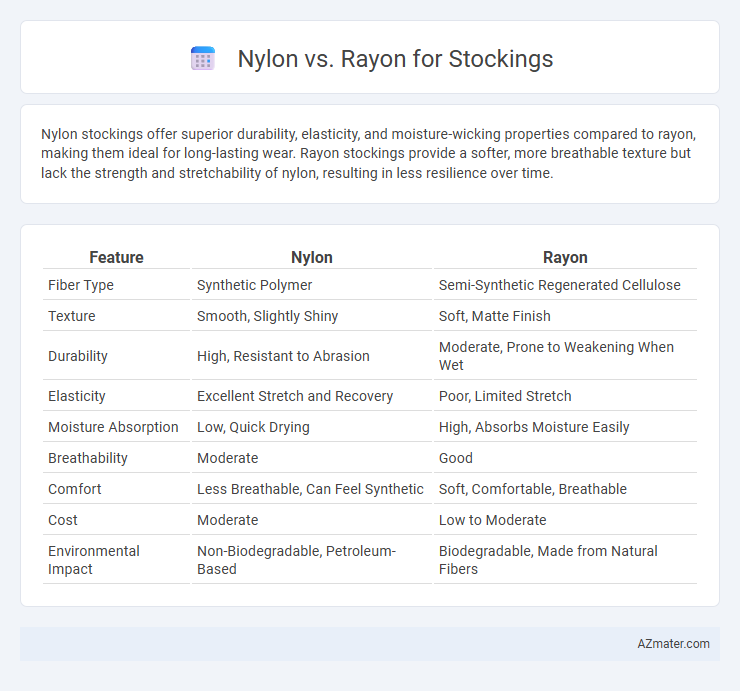Nylon stockings offer superior durability, elasticity, and moisture-wicking properties compared to rayon, making them ideal for long-lasting wear. Rayon stockings provide a softer, more breathable texture but lack the strength and stretchability of nylon, resulting in less resilience over time.
Table of Comparison
| Feature | Nylon | Rayon |
|---|---|---|
| Fiber Type | Synthetic Polymer | Semi-Synthetic Regenerated Cellulose |
| Texture | Smooth, Slightly Shiny | Soft, Matte Finish |
| Durability | High, Resistant to Abrasion | Moderate, Prone to Weakening When Wet |
| Elasticity | Excellent Stretch and Recovery | Poor, Limited Stretch |
| Moisture Absorption | Low, Quick Drying | High, Absorbs Moisture Easily |
| Breathability | Moderate | Good |
| Comfort | Less Breathable, Can Feel Synthetic | Soft, Comfortable, Breathable |
| Cost | Moderate | Low to Moderate |
| Environmental Impact | Non-Biodegradable, Petroleum-Based | Biodegradable, Made from Natural Fibers |
Introduction to Nylon and Rayon Stockings
Nylon stockings are made from synthetic polyamide fibers renowned for their strength, elasticity, and smooth texture, providing durability and a sheer finish ideal for hosiery. Rayon stockings, derived from regenerated cellulose fibers, offer a silky feel and excellent breathability, making them comfortable for extended wear. Both materials balance appearance and function, with nylon emphasizing resilience and rayon prioritizing softness and moisture absorption.
Fiber Origins: Nylon vs Rayon
Nylon fibers are synthetic, derived from petrochemicals through a polymerization process, offering durability and elasticity ideal for stockings. Rayon fibers originate from natural cellulose found in wood pulp, chemically regenerated to create a semi-synthetic fiber known for breathability and softness. The contrasting origins impact performance, with nylon providing strength and moisture resistance, while rayon enhances comfort and absorbency in stockings.
Manufacturing Process Comparison
Nylon stockings are produced through a synthetic polymerization process involving hexamethylene diamine and adipic acid, resulting in durable, elastic fibers formed via melt spinning. Rayon stockings, on the other hand, are created from regenerated cellulose derived from wood pulp, undergoing chemical treatments such as the viscose process to transform natural fibers into semi-synthetic filaments. The manufacturing of nylon emphasizes high tensile strength and resilience, while rayon production focuses on softness and breathability, impacting the final texture and performance of the stockings.
Durability and Strength Differences
Nylon stockings are renowned for their superior durability and tensile strength, making them resistant to tears and runs compared to rayon stockings. Rayon, while softer and more breathable, tends to weaken quickly when exposed to moisture and friction, resulting in lower overall longevity. The synthetic polymer structure of nylon provides enhanced elasticity and resilience, ideal for long-lasting stocking wear.
Comfort and Wearability
Nylon stockings offer excellent durability and elasticity, making them resistant to runs and providing a snug, supportive fit that enhances wearability. Rayon stockings provide superior breathability and moisture-wicking properties, resulting in enhanced comfort during extended wear, especially in warmer conditions. Both materials deliver distinct benefits, with nylon favoring strength and longevity, while rayon prioritizes softness and natural comfort.
Breathability and Moisture Management
Nylon stockings offer durability and a smooth finish but have lower breathability compared to rayon, often leading to less effective moisture management. Rayon, derived from natural fibers, excels in breathability and moisture absorption, providing a cooler, more comfortable wear in warm conditions. For optimal moisture control and ventilation, rayon stockings are preferable, especially for prolonged use in humid environments.
Appearance and Sheen
Nylon stockings offer a smooth, glossy finish that enhances fabric sheen and provides a sleek, polished look. Rayon stockings display a softer, more natural luster that mimics the subtle shine of silk, giving a delicate and elegant appearance. The choice between nylon and rayon depends on whether a high-shine, vibrant gloss or a muted, refined sheen is preferred for the desired stocking aesthetic.
Cost and Affordability
Nylon stockings are generally more affordable than rayon, offering a cost-effective option for everyday wear due to their synthetic fiber composition and mass production. Rayon stockings, while often pricier, provide a softer texture and better breathability but come at a higher manufacturing cost. Consumers looking for durability and budget-friendly choices typically prefer nylon, whereas those prioritizing comfort may opt for the slightly more expensive rayon alternatives.
Eco-Friendliness and Sustainability
Rayon is derived from natural cellulose fiber, making it more biodegradable and sustainable compared to petroleum-based Nylon, which has a higher carbon footprint due to its synthetic production process. Nylon requires less water and energy during manufacturing but generates non-biodegradable microplastics that persist in the environment. Choosing rayon over nylon for stockings reduces reliance on fossil fuels and minimizes long-term environmental impact through improved biodegradability and renewable resource use.
Best Uses and User Preferences
Nylon stockings excel in durability and elasticity, making them ideal for everyday wear and active lifestyles, while rayon stockings offer a softer, breathable texture preferred for comfort and formal occasions. Users seeking long-lasting, sheer hosiery often choose nylon for its resistance to runs and easy maintenance. Those prioritizing natural feel and moisture absorption lean towards rayon, valuing its smooth touch and suitability for sensitive skin.

Infographic: Nylon vs Rayon for Stocking
 azmater.com
azmater.com